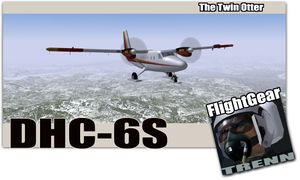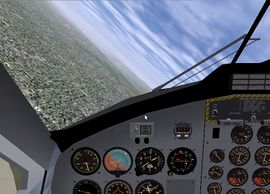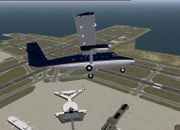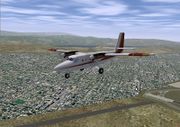De Havilland Canada DHC-6 Twin Otter
 | |
| Type | Utility aircraft |
|---|---|
| Author(s) | Syd Adams |
| FDM | YASim |
| --aircraft= | dhc6, dhc6F, dhc6S |
| Status | Development |
The DHC-6 Twin Otter is a 20-passenger STOL (Short Takeoff and Landing) utility aircraft developed by de Havilland Canada. It has often been called the most successful aircraft program in Canada's history.
Review
| This section contains a review. Please note that statements made here are (mostly based on) a single person's opinion. |
Flying the DHC6 model here in FG is a delightful experience. Take off is quick and climb rate is very good, although the thought of having undercarriage hanging out there at 180 knots is an annoying thought. Handling is crisp and responsive. Approach has to be made at about 120 knots in order to avoid running out of elevator control and landing hard at 1200 fpm which would have been either fatal or embarrassing to say the least. Check the trim settings as the aircraft tends to be trimmed very nose down by the autopilot. Disconnecting the autopilot does not reset the trim.
It was only after forgetting to set an altitude limit on the autopilot that I realized how stable the Twin Otter was; it climbed to about 15,000 ft at constant speed, at near full power setting and pitch.
The excursion gave me the opportunity to try out the navigation instrument on the aircraft. The radio was first tuned to 115.8 which is the familiar San Francisco VOR. Tuned using the drop down menu and not the equipment in the panel, since it was not intstalled - just an image of the radio stack exists, unlike in the 172 and the Beech 1900D. Maybe that could be transferred here.
In any case, the VOR needle was set by clicking and holding the hot spot near the knob at the bottom of the dial, eventualy the needle centred, with a little up arrow showing the "TO" flag. Reading off the compass heading from the dial, knew I had to head around 030 and so dialled in the heading in the autopilot.
After passing one or two perfectly good airports, I persisted, and ended up with the familiar runways in the distance. A high speed descent got me within touching distance of the runway, and the famous short landing of the twin otter was made.
Navigation, then, is quite possible with the basic standard instrumentation in the Twin Otter. Maybe a DME could be added from the 172.
Overall
A lovely upholstered cockpit with decent graphics and an attractive instrument panel completes the package. The visibility is very good through the wide windows and the extra downward view is very much appreciated.
The autostart function works, as does the menu driven autopilot.
The version tested was the version (dhc6_20111219.zip) on FG 1.9.1
Compatibility
- FlightGear 1.9.1.: Loads and runs
- FlightGear 2.6 : Listed on FG 2.6 download page
- FlightGear 2.12.1: Loads and runs
Specifications
- Never exceed speed: 170 knots (195 mph (314 km/h))
- Maximum speed: 170 knots (195 mph (314 km/h))
- Cruise speed: 150 knots (173 mph (278 km/h))
- Stall speed: 58 knots (VSO, gross weight, landing configuration)
- Range: 920 nautical miles (1,050 mi (1,690 km))
- Service ceiling: 25,000 ft (7,620 m)
- Rate of climb: 1,600 ft/min (8.1 m/s)
Gallery
External link
- Wikipedia
- http://www.blm.gov/pgdata/etc/medialib/blm/nifc/aviation/smokejumper.Par.91634.File.dat/SOPA_otter.pdf
| |||||


